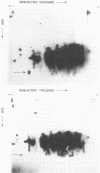Abstract
We present evidence for a two-step model for expression of the recessive phenotype at the diploid adenine phosphoribosyl transferase (aprt) locus in Chinese hamster ovary cells. This model proposes a high-frequency event leading to allelic inactivation and a low-frequency event leading to a structural alteration of the APRT protein. Either event can occur first, resulting in two types of heterozygous cells. The proposed model is based on analysis of Chinese hamster ovary presumptive aprt heterozygotes and APRT- mutants, derived by two different laboratories. The major class of heterozygotes (class 1) had approximately 50% parental APRT activity, 50% immunologically precipitable APRT protein, and only wild-type enzyme as based on two-dimensional gel electrophoresis and thermal inactivation studies. We propose that one allele at the aprt locus has been inactivated in these heterozygotes. APRT- mutants derived from any single class 1 heterozygote arose at a low frequency and contained either no immunologically detectable APRT protein or an APRT enzyme which was, in most cases, demonstrably altered. The second class of heterozygotes, consisting of two independent isolates, gave rise to APRT- cells at a high frequency (10(-3) to 10(-5). These heterozygous cell lines had 50% of parental APRT activity and only wild-type spot, or wild-type and an electrophoretic variant spot, on two-dimensional gels. These aprt heterozygotes appear to have arisen by mutation at one allele. APRT- mutants derived from either heterozygote of this class had all lost the wild-type activity, consistent with the proposed model.
Full text
PDF







Images in this article
Selected References
These references are in PubMed. This may not be the complete list of references from this article.
- Adair G. M., Carver J. H., Wandres D. L. Mutagenicity testing in mammalian cells. I. Derivation of a Chinese hamster ovary cell line heterozygous for the adenine phosphoribosyltransferase and thymidine kinase loci. Mutat Res. 1980 Sep;72(2):187–205. doi: 10.1016/0027-5107(80)90035-4. [DOI] [PubMed] [Google Scholar]
- Bradford M. M. A rapid and sensitive method for the quantitation of microgram quantities of protein utilizing the principle of protein-dye binding. Anal Biochem. 1976 May 7;72:248–254. doi: 10.1016/0003-2697(76)90527-3. [DOI] [PubMed] [Google Scholar]
- Bradley W. E., Letovanec D. High-frequency nonrandom mutational event at the adenine phosphoribosyltransferase (aprt) locus of sib-selected CHO variants heterozygous for aprt. Somatic Cell Genet. 1982 Jan;8(1):51–66. doi: 10.1007/BF01538650. [DOI] [PubMed] [Google Scholar]
- Bradley W. E. Reversible inactivation of autosomal alleles in Chinese hamster cells. J Cell Physiol. 1979 Nov;101(2):325–340. doi: 10.1002/jcp.1041010212. [DOI] [PubMed] [Google Scholar]
- Campbell C. E., Worton R. G. Segregation of recessive phenotypes in somatic cell hybrids: role of mitotic recombination, gene inactivation, and chromosome nondisjunction. Mol Cell Biol. 1981 Apr;1(4):336–346. doi: 10.1128/mcb.1.4.336. [DOI] [PMC free article] [PubMed] [Google Scholar]
- Chasin L. A. Mutations affecting adenine phosphoribosyl transferase activity in Chinese hamster cells. Cell. 1974 May;2(1):37–41. doi: 10.1016/0092-8674(74)90006-3. [DOI] [PubMed] [Google Scholar]
- Davidson J. N., Patterson D. Alteration in structure of multifunctional protein from Chinese hamster ovary cells defective in pyrimidine biosynthesis. Proc Natl Acad Sci U S A. 1979 Apr;76(4):1731–1735. doi: 10.1073/pnas.76.4.1731. [DOI] [PMC free article] [PubMed] [Google Scholar]
- Gupta R. S., Siminovitch L. Genetic and biochemical studies with the adenosine analogs toyocamycin and tubercidin: mutation at the adenosine kinase locus in Chinese hamster cells. Somatic Cell Genet. 1978 Nov;4(6):715–735. doi: 10.1007/BF01543160. [DOI] [PubMed] [Google Scholar]
- Hershey H. V., Taylor M. W. Purification of adenine phosphoribosyltransferase by affinity chromatography. Prep Biochem. 1978;8(6):453–462. doi: 10.1080/00327487808061662. [DOI] [PubMed] [Google Scholar]
- Jones G. E., Sargent P. A. Mutants of cultured chinese hamster cells deficient in adenine phosphoribosyl transferase. Cell. 1974 May;2(1):43–54. doi: 10.1016/0092-8674(74)90007-5. [DOI] [PubMed] [Google Scholar]
- LYON M. F. Gene action in the X-chromosome of the mouse (Mus musculus L.). Nature. 1961 Apr 22;190:372–373. doi: 10.1038/190372a0. [DOI] [PubMed] [Google Scholar]
- Laemmli U. K. Cleavage of structural proteins during the assembly of the head of bacteriophage T4. Nature. 1970 Aug 15;227(5259):680–685. doi: 10.1038/227680a0. [DOI] [PubMed] [Google Scholar]
- Morrow J. Gene inactivation as a mechanism for the generation of variability in somatic cells cultivated in vitro. Mutat Res. 1977 Sep;44(3):391–400. doi: 10.1016/0027-5107(77)90097-5. [DOI] [PubMed] [Google Scholar]
- O'Farrell P. H. High resolution two-dimensional electrophoresis of proteins. J Biol Chem. 1975 May 25;250(10):4007–4021. [PMC free article] [PubMed] [Google Scholar]
- O'Neill J. P., Hsie A. W. Chemical mutagenesis of mammalian cells can be quantified. Nature. 1977 Oct 27;269(5631):815–817. doi: 10.1038/269815a0. [DOI] [PubMed] [Google Scholar]
- Oakley B. R., Kirsch D. R., Morris N. R. A simplified ultrasensitive silver stain for detecting proteins in polyacrylamide gels. Anal Biochem. 1980 Jul 1;105(2):361–363. doi: 10.1016/0003-2697(80)90470-4. [DOI] [PubMed] [Google Scholar]
- Rabin M. S., Gottesman M. M. High frequency of mutation to tubercidin resistance in CHO cells. Somatic Cell Genet. 1979 Sep;5(5):571–583. doi: 10.1007/BF01542695. [DOI] [PubMed] [Google Scholar]
- Siminovitch L. On the nature of hereditable variation in cultured somatic cells. Cell. 1976 Jan;7(1):1–11. doi: 10.1016/0092-8674(76)90249-x. [DOI] [PubMed] [Google Scholar]
- Switzer R. C., 3rd, Merril C. R., Shifrin S. A highly sensitive silver stain for detecting proteins and peptides in polyacrylamide gels. Anal Biochem. 1979 Sep 15;98(1):231–237. doi: 10.1016/0003-2697(79)90732-2. [DOI] [PubMed] [Google Scholar]
- Taylor M. W., Pipkorn J. H., Tokito M. K., Pozzatti R. O., Jr Purine mutants of mammalian cell lines: III. Control of purine biosynthesis in adenine phosphoribosyl transferase mutants of CHO cells. Somatic Cell Genet. 1977 Mar;3(2):195–206. doi: 10.1007/BF01551814. [DOI] [PubMed] [Google Scholar]
- Thompson L. H., Brookman K. W., Carrano A. V., Dillehay L. E. Role of DNA repair in mutagenesis of Chinese hamster ovary cells by 7-bromomethylbenz[a]anthracene. Proc Natl Acad Sci U S A. 1982 Jan;79(2):534–538. doi: 10.1073/pnas.79.2.534. [DOI] [PMC free article] [PubMed] [Google Scholar]
- Thompson L. H., Fong S., Brookman K. Validation of conditions for efficient detection of HPRT and APRT mutations in suspension-cultured Chinese hamster ovary cells. Mutat Res. 1980 Feb;74(1):21–36. doi: 10.1016/0165-1161(80)90188-0. [DOI] [PubMed] [Google Scholar]
- Tischfield J. A., Trill J. J., Lee Y. I., Coy K., Taylor M. W. Genetic instability at the adenine phosphoribosyltransferase locus in mouse L cells. Mol Cell Biol. 1982 Mar;2(3):250–257. doi: 10.1128/mcb.2.3.250. [DOI] [PMC free article] [PubMed] [Google Scholar]




